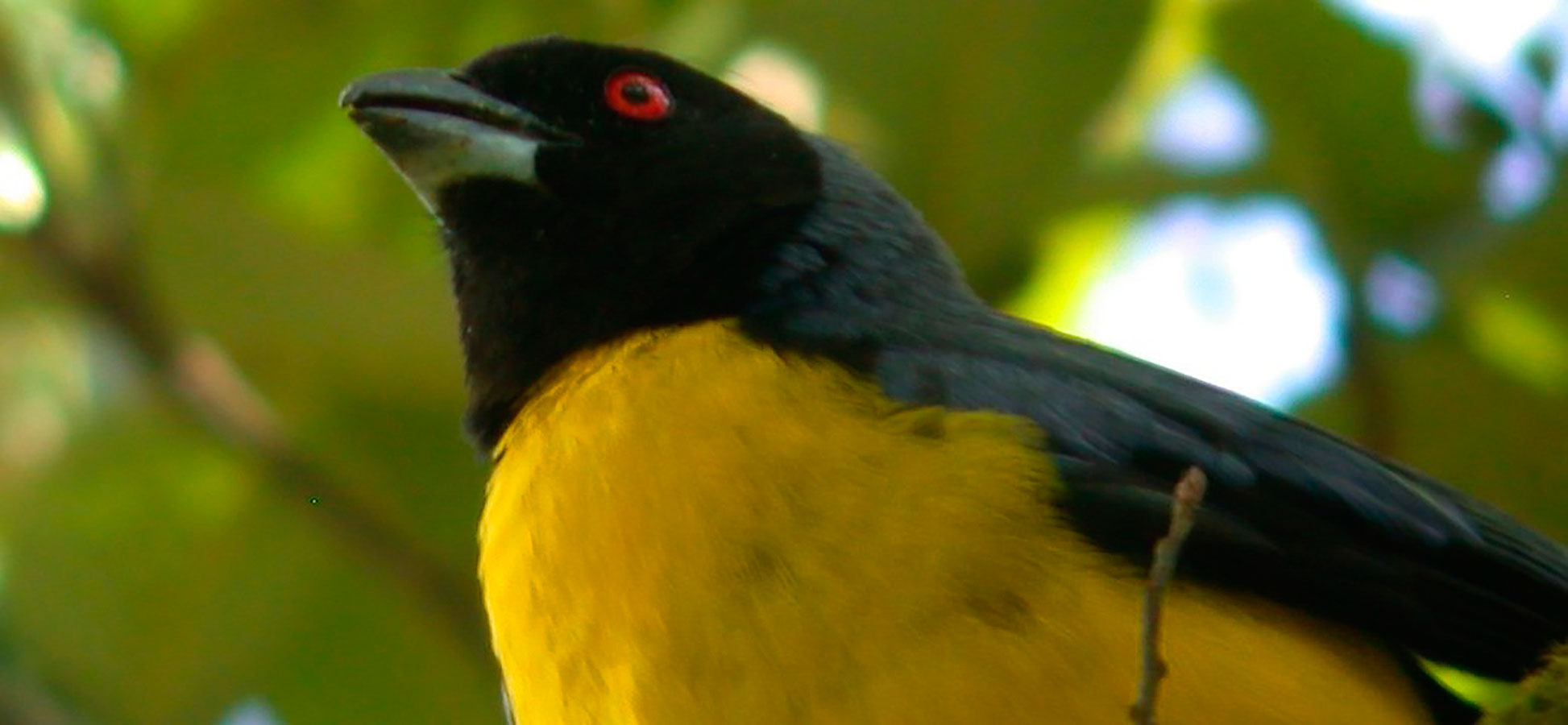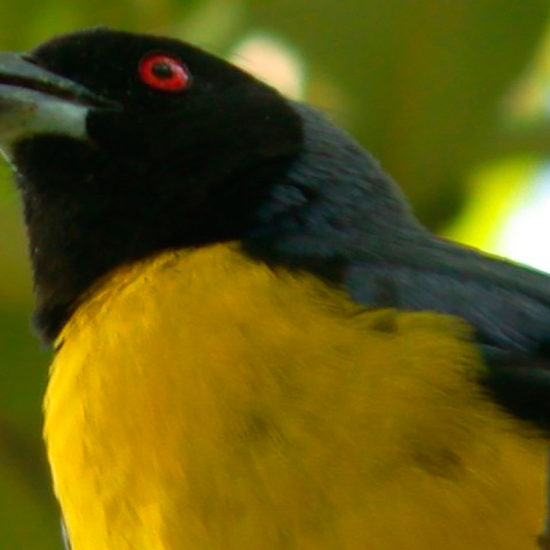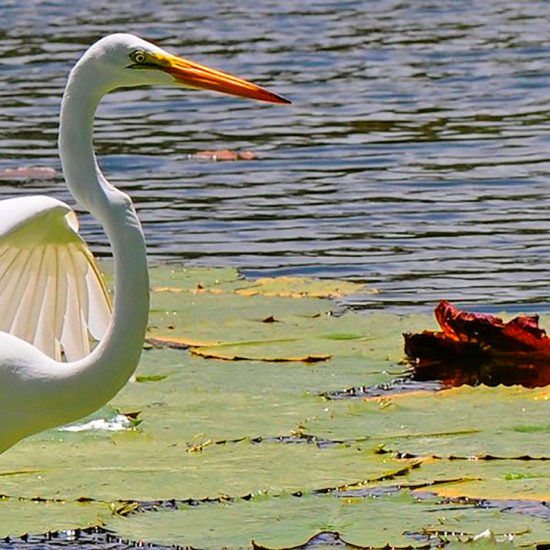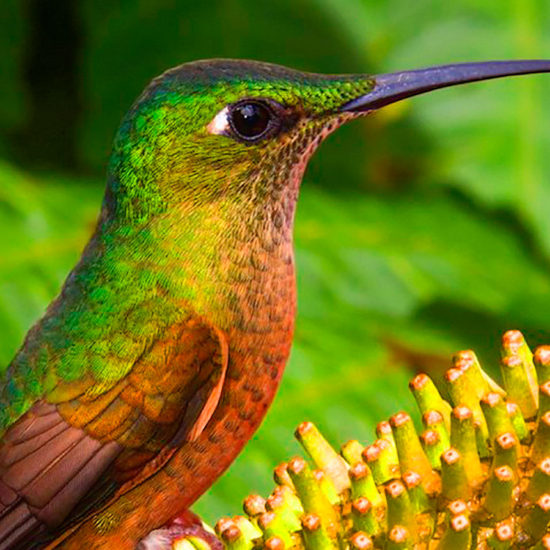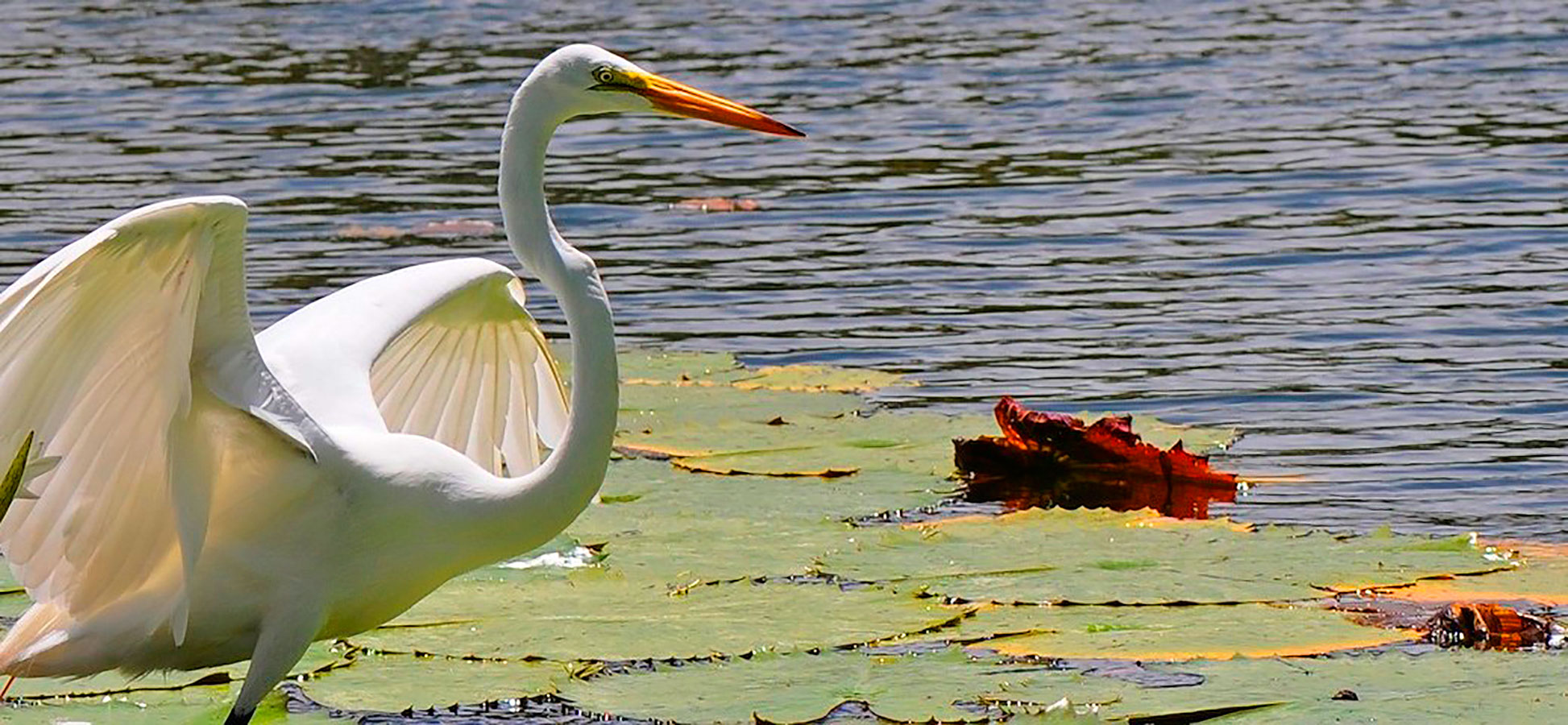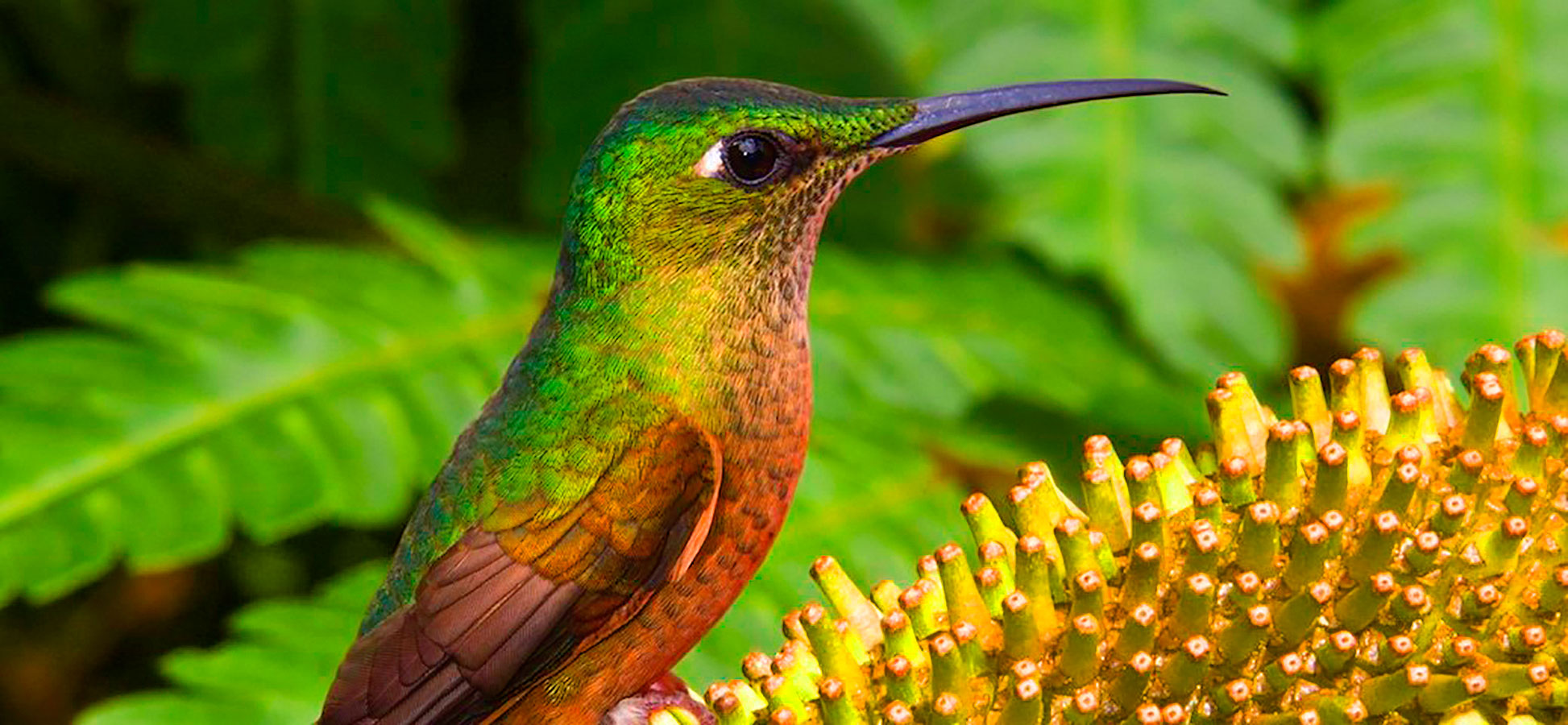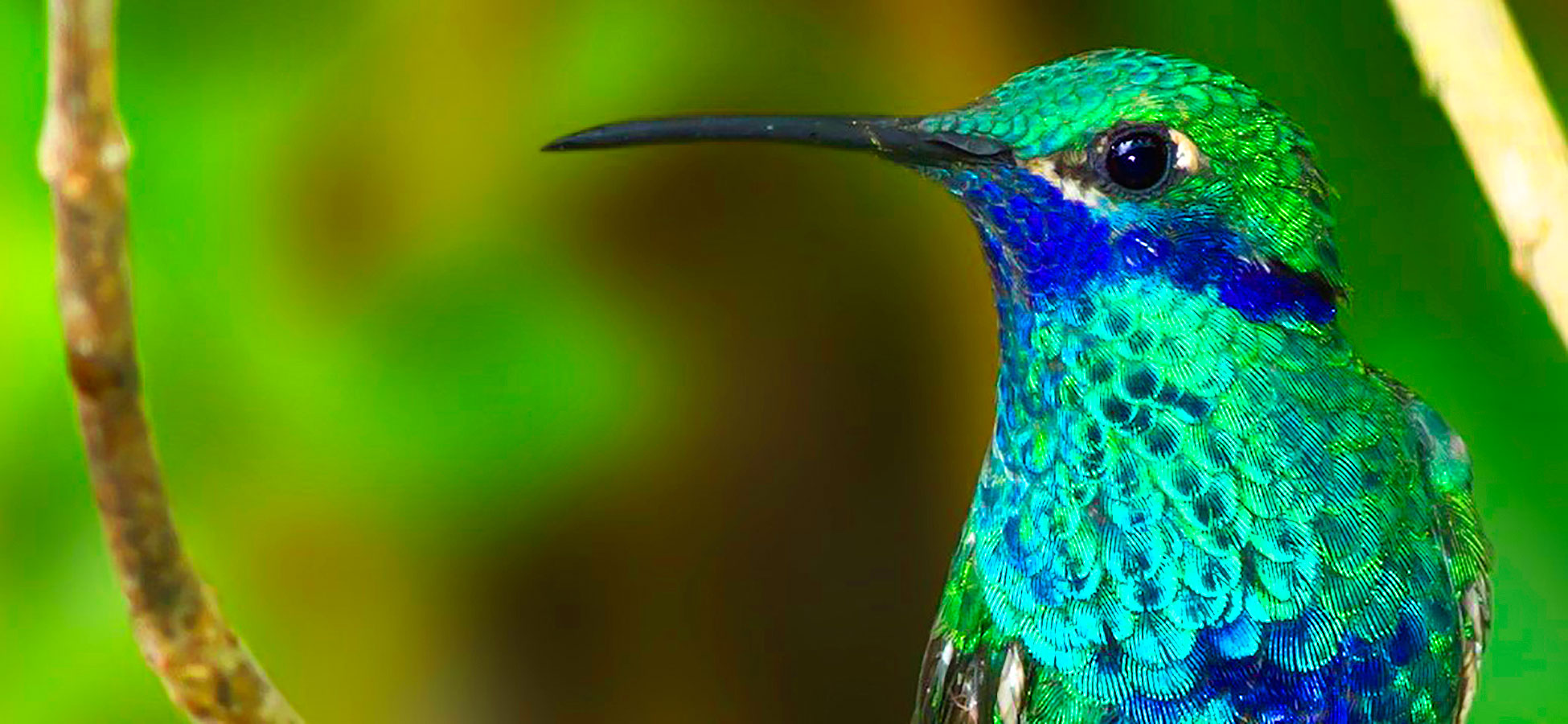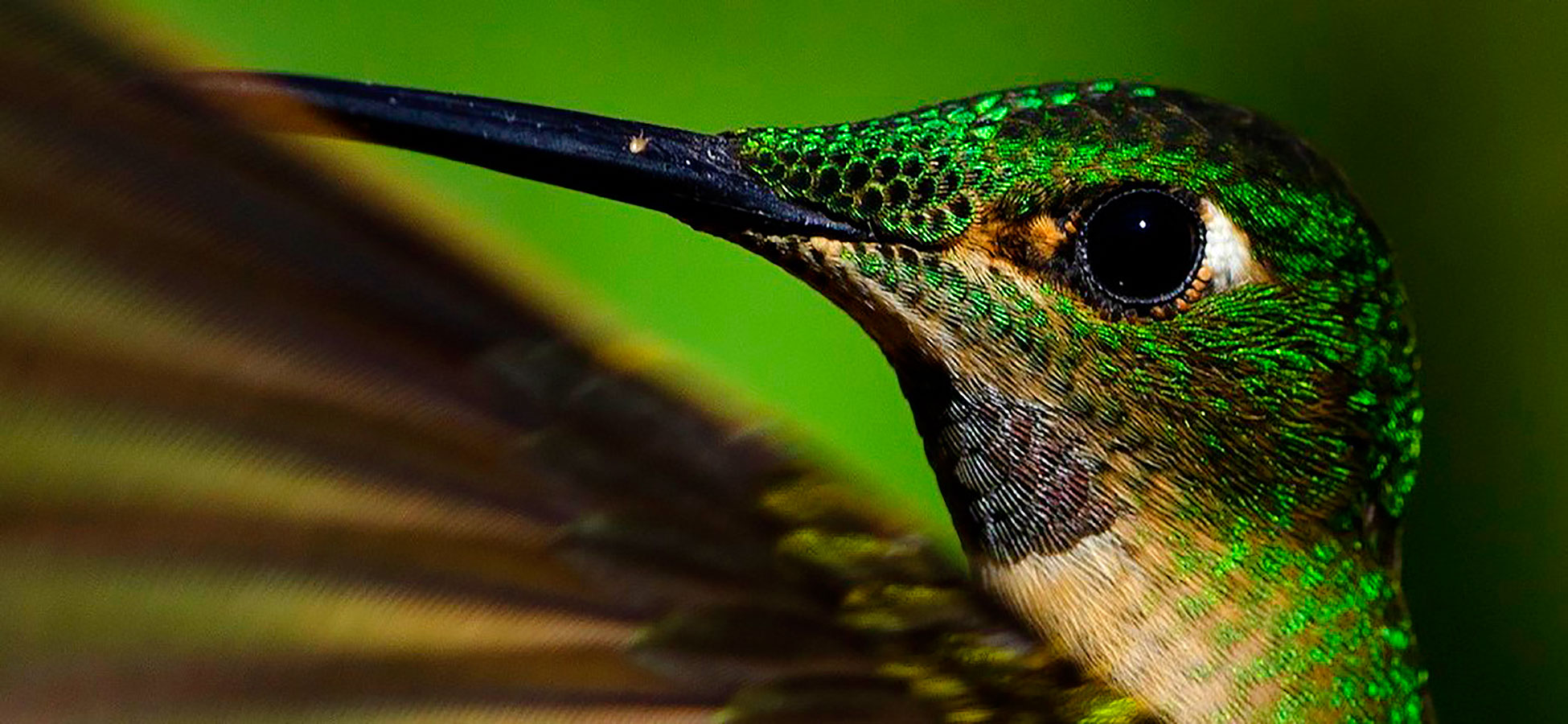Birdwatching in the Highlands, Cloud Forest and Rainforest
Ecuador is a nature lover’s paradise. The wide variety of habitat — from tropical rainforest to cloud forest, high paramos, mangrove swamps, and the dry Pacific coast — make our country home to the highest diversity of birds in the world and one of the greatest numbers of species of flora and fauna. The following 12-day sample itinerary gives a glimpse of the different regions that can be visited. Tours can be designed to include all or some of the areas described. Please contact us for further information.
Birding North Ecuador: Highland, Cloud Forest, and Rainforest
Day 1:
Early morning drive out of Quito on the old road to Nono-Mindo. Stop at Yanacocha Reserve located 45 minutes from Quito on the western side of the Pichincha volcano where we might expect to find the Black-breasted Puffleg (*Eriocnemis nigrivestis*), a hummingbird that is critically threatened, as well as a few other globally endangered bird species such as: Andean Guan, Scarlet-bellied Mountain Tanager, Black-chested Mountain Tanager, Great Sapphire Winged, and Shining Sunbeam.
Altitude range: 3200-4400 masl
Continue our journey to the Mashpi-Amagusa Reserve where we may spot Indigo Flowerpiercer, Black Solitaire, Moss-backed Tanager, or Flame-faced Tanager. The specific location of this forest within this IBA makes it even more special since this area is the last foothill forest that directly connects to the lower subtropical westernmost forest of Ecuador. Its unique location makes it particularly attractive for birders looking for the highest biodiversity regions, including the Choco forest endemic birds. The altitude range is 1700-750 masl.
Overnight accommodation in comfortable and clean lodges, in private rooms with bathroom and shower.
Day 2:
This area was recently declared a protected forest of Mashpi-Guaycuaycu-Sahuangal, and therefore logging is now prohibited. The local people of the area have received training in conservation and support from the local governments and by the Aves y Conservación organization, an operating branch of Bird Life in Ecuador.
The owners of the place have been working for the last two years to change their farming habits to include conservation ideas and improve this protected habitat. As part of this process, they have registered their property as a formal reserve in the hope that, as the forest keeps its natural renovation process, it will get more birders to visit the place. The plan is to improve the sustainability of their reserve and to provide a complete ecological birding experience which will include homegrown food, lodging, trails, feeders, and guiding.
Currently, they have set up a small but nice hummingbird garden with a few well-visited feeders that attract some of the most sought-for Choco endemic hummingbirds like the Empress Brilliant, Velvet-purple Coronet, Violet-tailed Sylph, Brown Inca, Purple-bibbed Whitetip, and White-whiskered Hermit. The hummingbird garden also has a shelter where you can comfortably look at these colorful birds even when it is raining.
Apart from hummingbirds, we can find the Andean Bill-billed Toucan, Quetzals, Trogons, or brightly colored tanagers that can be seen up close. Some of the local tanagers are also attracted to feeders, so you will be able to see and even photograph many of the Choco endemic species like the Glistening-green Tanager and the Black-chinned Mountain Tanager. Other Choco endemics that can be seen in the reserve or along the road are: Rose-faced Parrot, Orange-fronted Barbet, Toucan Barbet, Orange-breasted Fruiteater, Moss-backed Tanager, Choco Vireo, Long-wattled Umbrellabird. If you are a serious birder, you may want to consider a two-day birding trip to cover the higher altitude forest just past Pacto Alto, the entire Amagusa road, the Amagusa Reserve, and continue to the lower forest of Pachijal, Mashpi; ending with a stay at another conservation project in Mangaloma at 700 masl.
Overnight accommodation in comfortable and clean lodges, in private rooms with bathroom and shower.
Day 3:
Mid-morning journey to Bellavista Cloud Forest Reserve near the Tandayapa Valley. They are in the core area of the UNESCO-declared “Choco Andino de Pichincha Biosphere Reserve”. The Choco Andean cloud forest of Ecuador is a unique biodiverse ecosystem with its unique flora and fauna. Located at the foothills of the Andes, it is characterized by its high humidity, constant fog, and a cool and pleasant temperature. This forest is vital for freshwater supply and climate regulation in the region.
Some of the birds that can be seen in this area are: Violet-tailed Sylph, Brown Inca, Collared Inca, Striped Treehunter, or Masked Trogon.
Overnight at Bellavista Lodge or similar
Altitude range: 1514-3184 masl
Day 4:
Spend the morning in the surroundings of Bellavista. Here we may find the Turquoise Jay and the Buff-tailed Coronet. In the afternoon, we start our journey back to the valley of Puembo located in the Quito metropolitan district. We will take any opportunity to find as many as possible of the 800 recorded species of birds in the Metropolitan District of Quito that surround the city. This high diversity is achieved thanks to the many different ecosystems within the district of Quito which include: paramo grassland, Polylepis forests, arid scrub, temperate zone, rural woodland, farmland, and forests at various elevations such as elfin, montane, subtropical, and foothill where the greatest numbers of birds concentrate.
The presence of Great Thrush, Sparkling Violetear, Western Emerald, or Black-tailed Trainbearer among others such as the Yellow Grosbeak.
Overnight at a local hotel.
Day 5:
Early morning visit to the paramos of the Antisana Volcano, looking for the Andean Condor. It takes more than one hour to get to La Mica Lagoon at 3920 masl
Antisana is a majestic and mysterious volcano on the western Andean mountain range. At this high elevation, we find moorlands and western Andean forests. As a result of its past volcanic activity and glacial events, we can now enjoy amazing landscapes with its highly specialized and characteristic flora and fauna. Mirroring the volcano, we find the Mica Lagoon, which supplies most of the fresh water for human consumption in Quito. Aside from the main lagoon, we can observe a complex system of marshes and swampy areas where water collects during the rainy season, forming seasonal lagoons and a network of streams that drain into the Amazon basin. The level of biodiversity within the reserve is remarkable with 418 bird species, 73 mammals, and 61 amphibians and reptiles recorded within the reserve which include spectacled bear, white-tailed deer, dwarf deer, goat-deer, pumas, Andean cats, Andean wolves, condor, caracara, Andean seagull, mountain tapir, and lizards among others. At this altitude, we can expect to see the Carunculated Caracara, Andean Hillstar, Stout-billed Cinclodes, Plumbeous Sierra-Finch, Andean Ibis, Many-striped Canastero, or Giant Hummingbird.
In the afternoon we continue our journey west to Guango Lodge at 2717 masl, not far from the Antisana moorlands and the hot springs of Papallacta. Guango Lodge is another paradise for hummingbird lovers and photographers. Seeing 14 species of hummingbirds within an hour is not uncommon, and the Sword-billed Hummingbird with its unique, long bill will surely amaze you. Its scenic vistas and the variety of trails offer the visitor great opportunities to hike in a beautiful setting surrounded by cloud forest-covered mountains teeming with birds. This small, cozy lodge is right in the middle of it all.
Overnight at Guango Lodge.
Day 6:
Spend the morning on Guango Lodge trails. Afternoon trip to San Isidro Lodge located in the vicinity of the town of Cosanga about one hour and a half away. San Isidro Reserve is nestled in the picturesque Quijos Valley, on the westernmost headwaters of the Amazon basin at an elevation of about 2,050 m (6,800 ft.) above sea level in a zone still mostly blanketed by extensive humid forest. But the trails lead through habitats from 2,400 meters all the way down to 1,900 meters. The majority of the forests at San Isidro are what most newcomers to the tropics envision: large hardwood trees draped with lush mosses that support a seemingly endless number of orchids and bromeliads. Cabañas San Isidro and its immediate surroundings boast a bird list of about 330 species, many of which are more easily found here than anywhere else in the country. Some of the birds present in the area are: the Inca Jay, Chestnut-breasted Coronet, Violet-fronted Brilliant, Smoke-colored Pewee, Scarlet-rumped Cacique, Speckled Hummingbird, Russet-backed Oropendola, and Black-billed Peppershrike.
Overnight at San Isidro Lodge
Day 7:
Visit the trails and surroundings of San Isidro at the Guacamayo Ridge. The famous Guacamayo Ridge is one of the best birding locations in the eastern Andes and for good reason. Cut into the side of a steep ridge, the stone path heads southeast for many miles, passing through pristine cloud forest in the mountains near Cosanga in the eastern Andes. Among the birds that we will be looking to see here are the Greater Scythebill, Peruvian Antpitta, Barred Antthrush, Andean Potoo, and many more. The Black-banded Owl can also be spotted in the surroundings of the lodge.
Overnight at San Isidro Lodge
Day 8:
Spend the morning on San Isidro trails or start our journey downhill to WildSumaco Lodge located at 1400 masl. A great mix of cloud forest species occur here, including Ochre-breasted Antpitta, Barred Parakeet, and Lemon-browed Flycatcher. Foothill species that we can see include Wing-banded Wren, Foothill Stipplethroat, and Napo Sabrewing, while upper-Amazonian species are also on the list; among them, Buckley’s Forest-Falcon and Gould’s Jewelfront. Nestled in the eastern foothills of the Andes, WildSumaco Lodge is strategically located for adequate birding, flora, and fauna viewing with a panoramic view across the Pucuno River valley and beyond to the Andes. On clear days, the distant snow-capped heights of the Antisana, Altar, and Tungurahua volcanoes glow white against the brilliant blue sky. To the north of the lodge is the Sumaco National Park and we can often see the Sumaco volcano peeking through the clouds and mist that surrounds its heights. From other parts of our reserve looking south and east, the Napo Galeras National Park is one of the most biodiverse spots especially for birds. Let your senses and imagination wander to the distant Amazonian lowlands stretching as far as the eye can see. WildSumaco Lodge is located at a comfortable altitude of 1480 m
Overnight at WildSumaco Lodge
Day 9,10 and 11:
After an early breakfast, we drive east to the town of Coca for approximately a 2-hour journey. In Coca, we take a motorized canoe to get to one of the Amazon basin lodges located a little over 2 hours downstream on the riverbank of the Napo River.
Apart from some specific differences, these local lodges offer comfortable accommodations with private facilities, excellent food, and the assistance of knowledgeable local guides. We recommend a tour of a minimum of 4 days/3 nights at one of these places which are amazing for birders and nature lovers. The exuberance of the Amazon primary forest shows incredible biodiversity at this altitude, about 277 masl. Most of the lodges in the area are located close to Yasuni National Park; apart from a local community project lodge that runs inside the national park. Reaching the eco-lodge is venturing into the almost unexplored wonders of the Amazon. Through river routes and land trails, we will engage deeply within the majesty of the jungle where each step will connect us to our wonderful surroundings, enhancing the experience that makes Yasuní such a unique reserve in the world.
Day 12:
After 3 nights discovering this Tropical Rainforest paradise with its incredible amount of birds and wildlife, we will return to Quito after a 40-minute flight from the town of Coca. (See Amazon lodges descriptions on our website).
- Location: Nature and Wildlife Tours
- Duration: 12 days / 11 nights
- Start / End: Quito / Quito
- Activities: Bird watching, hiking / walking
- Highlights: Mashpi-Amagusa Choco cloud forest, Antisana Volcano reserve, Guango-San Isidro-Guacamayos Ridge westernmost headwaters ecosystems of the Amazon Basin. Wildsumaco.
- Season: All year
- Included: All activities and visits mentioned in itinerary, transportation, accommodation, bilingual birder guide
- Not Included: Drinks, tips, meals not mentioned in itinerary, domestic and international flights
- Prices: Priced on request
-
Included
BirdwatchingNature
-
Not Included
CultureFlightsGalapagos Migratory FeePark FeeSoft adventureTips & GratuitiesYoga



